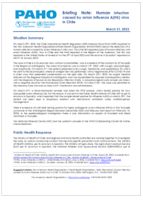
#17,384
Via the Pan American Health Organization (PAHO) we get a considerably more detailed look at Chile's first reported H5N1 infection, which we first learned about on Wednesday of this week.
As we saw with the Ecuadorian case last January, it took a full week of hospitalization before an avian H5 flu diagnosis could be reached.
The patient's initial PCR test (nasopharyngeal swab) on the 22nd was negative, and it wasn't until a (more invasive) bronchoalveolar sample was taken on the 27th, that an unsubtypable influenza A was detected.
It would take another 2 days (March 29th) before H5N1 could be confirmed by the Public Health Institute of Chile.
Despite the delay, this patient was lucky to be admitted to a relatively new, well equipped 671-bed hospital (Antofagasta Regional Hospital), where proper testing could be conducted. There are far too many places in the world where that type of testing is simply unavailable.
Although PCR testing is the `gold standard' for H5N1, it is not infallible.
How and from where samples are collected can affect its reliability (see CDC Guidance Interim Guidance on Testing and Specimen Collection), and even when done properly it can sometimes require several tests to return a positive result.
Exactly how this patient was exposed to H5N1 remains unknown, but the epidemiological investigation is ongoing. First the PAHO briefing, after which I'll return with a bit more.
Briefing Note: Human infection caused by avian influenza A(H5) virus in Chile
March 31, 2023
Situation Summary
On March 29 th , 2023, the Chile International Health Regulation (IHR) National Focal Point (NFP) reported to the Pan American Health Organization/World Health Organization (PAHO/WHO) about the detection of a human infection caused by avian influenza A (H5) virus. This is the first reported case of human infection with avian influenza A(H5) 1 virus in Chile and the third reported in the Region of the Americas: the first was reported in the United States of America 2 on the 29 th of April 2022 and the second in Ecuador 3 , reported on the 9 th of January 2023.
The case in Chile is a 53-year-old man, without comorbidities, who is a resident of the coastal city of Tocopilla in the Region of Antofagasta. The onset of symptoms was on March 13th , 2023, with cough, odynophagia, and dysphonia .
On March 21st , the patient presented a dry cough, headache, and palpitations, for which he went to the local hospital, where an antigen test was performed, with a negative result for COVID-19 and a chest x-ray that presented condensation on the right side.On March 22nd , 2023, he sought medical attention at the Regional Hospital of Antofagasta, and was hospitalized for dyspnea and respiratory distress, with the diagnosis of Severe Acute Respiratory Infection (SARI).
A nasopharyngeal swab sample was taken, with a negative result for the Polymerase Chain Reaction (PCR). On March 23rd , the case was admitted to the Intensive Care Unit and on March 24th , Oseltamivir was administered.
On March 27th, a bronchoalveolar sample was taken for PCR analysis , which tested positive for non-subtypable avian influenza (AI). For this reason, it was sent to the Public Health Institute of Chile ( ISP as per its acronym in Spanish), which reported that the sample tested positive for influenza A(H5) on March 29th . The patient has been kept in respiratory isolation with mechanical ventilation under multidisciplinary management.
There is evidence of wild birds testing positive for highly pathogenic avian influenza (HPAI) in the Tocopilla commune of the Antofagasta Region between December 2022 and February (last report on February 14, 2023). In the epidemiological investigation there is only information on reports of stranded and dead mammals in Tocopilla.
The National Influenza Centre (NIC) sent the patient's samples to the WHO Collaborating Centre for further characterization.
Public Health Response
The Ministry of Health of Chile and regional and local health authorities are working together to investigate the case, as well as conducting contact tracing and specific prevention and control actions. The Ministry of Health ( MINSAL per its acronym in Spanish), the Ministry of Agriculture, the Agricultural Livestock Service (SAG per its acronym in Spanish), the National Fisheries and Aquaculture Service (SERNAPESCA per its acronym in Spanish), carry out intersectoral activities in order to follow up on HPAI outbreaks in birds and mammals in the Antofagasta region. In terms of risk communication , MINSAL has informed the population about this case, in addition to prevention measures through messages for different audiences.
PAHO/WHO is supporting Chilean health authorities in the management of this event.
Since November 2022, PAHO has been alerting countries to the increasing detection of outbreaks of highly pathogenic avian influenza in birds and on the risk of human cases due to exposure to infected poultry or contaminated environments.
PAHO offers countries recommendations to strengthen intersectoral work on surveillance, early detection, and investigation of influenza events in the human-animal interface, which are available at:
https://bit.ly/3G8e4T2
Pan American Health Organization • http://www.paho.org • © PAHO/WHO, 2023
Three days ago, in UK Novel Flu Surveillance: Quantifying TTD, we looked at a sobering appraisal by the UK's Health Security Agency which believes that current surveillance systems (in the UK) could take several weeks before they would likely detect the community spread of a novel flu virus like H5N1.
Updated 29 March 2023
(EXCERPT)
3.3 Time to detection
The above scenarios are used to derive estimates of time to detection (TTD) of avian influenza under various testing scenarios. This is based on the assumption of sustained person to person transmission, and no cross-immunity from previous influenza vaccination or infection.
Worst case, they suggest that it might take 10 weeks, and nearly 1,200 local infections, before community spread would be signaled.
Best case, nearly 3 weeks and 3 dozen cases.
A reminder that, by the time we know the next pandemic has started, it will almost certainly have been spreading under the radar for weeks or even months.
